MAGALOGUE SIX

COVER IMAGE
Heading for teh Shore
LOTTE GLOB
hand-coloiured etching | 41cm x 60cm
+44 (0) 1463 783 230
art@kilmorackgallery.co.uk
Kilmorack Gallery, inverness-shire iv4 7al SCOTLAND
Contents Magalogue 6 5 What’s in a Pot? Patricia Shone on stone, clay and fire. Weaving Land and Sky 12 Lizzie Rose The Pause Between Waves 16 Library of the Blind 18 worlds within worlds, by Tony Davidson Three Questions to 24 Survival Man 28 from the vaults 30
4
Magalogue 6
It is a huge privilege to work with so many artists, and to collect their thoughts, and mine, in these magalogues. With each edition I learn something new.This time I am struck by how very physical our worlds is. The ceramic artists in this edition – Lotte Glob and Patricia Shone – are so rooted in the earth that its use is unavoidable. It is literally their source material, and stories come with it: geological tales and ghosts from archaeological time. Ceramic artists translate these and make them touchable again. Robert Powell’s works are also very real, but once removed, like a mirror. Put a silly hat on, and it will appear in the painting. They are a library of the silly hats we’ve worn and the ultimately futile ventures we’ve made.
Tony Davidson Director of Kilmorack Gallery

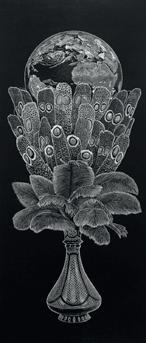

The Peaks | ROBERT POWELL Another Life | ADE ADESINA
Crocosmia Vortex | SHONA BARR


 Landscape Study ii | KIRSTIE COHEN
Flowers on a Pink Ground | ANN ORAM
Earth Strata Jar | PATRICIA SHONE
Landscape Study ii | KIRSTIE COHEN
Flowers on a Pink Ground | ANN ORAM
Earth Strata Jar | PATRICIA SHONE
What’s in a Pot?
Patricia Shone on stone, clay and fire.
 by Patricia Shone
Erosion Bottle, 2022 raku
13cm(h) x 10cm(d)
by Patricia Shone
Erosion Bottle, 2022 raku
13cm(h) x 10cm(d)
Patricia Shone’s work is sought after globally.She’s just sent a large box to NewYork and another to Italy,but her work is inspired by the purist of things:stone,clay and fire.In her own words...
Thefeel of raw clay in my hands is my prime motivation for making. It is a physical connection to the physical world around me - a visceral process, not always comfortable, often challenging and increasingly tiring. Clay is a broad and complex medium demanding practical solutions which helps balance the introspection that comes from working alone. I have learned to give precedence to the physical process over and above intellectual input, allowing my inner and non-verbal senses to give voice to the work.
My work is hand formed in all aspects of its concept and creation. It is about finding the points of contact and balance between the maker and the material. It is inspired by the control of form in quotidian functional vessels whilst releasing the piece from the constraints of function by the techniques used to develop the surfaces. It is material and maker working together, neither having mastery over the other.
The formation of clay is mostly from the climatic erosion of rock (a few come from in situ weathering). The origins of the material lie in the enduring rock beneath our feet. The processes of firing that a potter uses to complete their work replicate the monumental forces of heat which create the original rocks.
9
I use hand forming methods developed during a period of ill health when I was unable to throw or hold more than a handful of clay. The technique is one of stretching the clay, opening out it’s matrix to develop and extenuate the inherent textures within the clay, a combination of control and release.
The nature of clay used in this way allows it to speak of the continued erosion and weathering of the land we live on; the traces made by the passage of humans across the surface of our planet and the tensions of the container and its contents. It is an expression of myself as an individual and of the human history of the material and how it connects one person to another, across civilisations, a bowl passed from one hand to another’s.
 Patrica Shone, February 2023
Patrica Shone, February 2023
10
Erosion Bowl raku 17cm(h) x 17cm(d)

Weaving Land and Sky

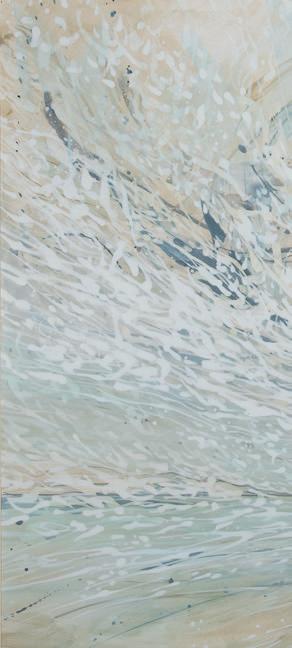 Lizzie Rose
by Lizzie Rose
Lizzie Rose
by Lizzie Rose
Lizzie Rose, like all sensible people, finds elation in nature. This is the Northern RomanticTradition, in which she has found her own strong, drawn way to express its wonders and its nessesity.

Mywork has always been about our relationship with the rest of nature – what we give and what we gain. The human-induced climate crisis we face brings the balance of our relationship with the rest of nature into ever more stark terms. I have always been aware of our destructiveness on our surroundings, and our need to care for it, and I am in awe of the energy I feel outside, in my relationship with my environment. In nature, I feel joy and understand new knowledge about myself and my place in the world.
Now we have woken up – realising not just the beauty but what we have to lose, and our destructiveness within this. Now is the time to really think, to be acting differently, to be caring. It’s hard to put into words – so I make marks, in response, in awe, in reflection, in reverence, curiosity and integrity, spirit and energy… gained and reflected, I hope.
Woven marks, exploratory, intricate, strong; of the feminine and the land.Weaving layers of meaning, of movement, history and thought. Interconnected, in a delicate balance, a tipping point where it all may unravel. Stitches in air, the air we breathe, connecting us, weaving us into our surroundings, woven from the energy of place. Treading lightly, weaving a careful path upon the earth
Life and growth, reflected in the energy of my marks are a joyous response to growth and life in its simplicity and in observing new life bursting forth. Sweet Peas, annually intriguing in their wild growth, tendrils drawing in the air, delicate and vivacious, exuding life, upwards, weaving patterns around and up.

The hidden landscape of night. An inner landscape, meditative, contemplative, infinite, enormous. Light in the darkness, energy in the hidden places and quiet time. A different light, a different energy, reflected. Recovery, peace, magic and mystery, fear and loss. The full moons evocative in their names, full of story, linking us to the cycle of the months and years, the stories we tell ourselves.
 Sweet Pea 4 acrylic and pencil 29cm x 29cm
Sweet Pea 4 acrylic and pencil 29cm x 29cm

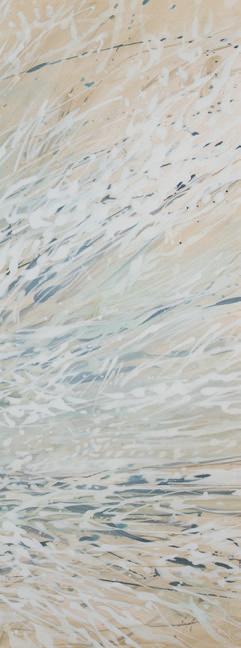
The Library of the Blind or Memory of Babel

ROBERT POWELL | etching and waterolcour 39cm x 58.5cm
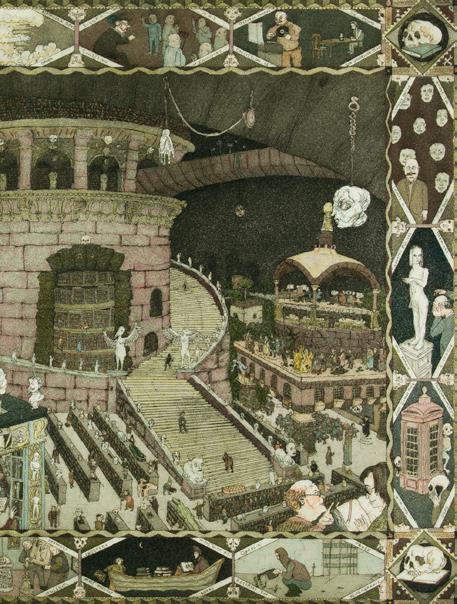
Library of the Blind
where a point in space contains all points
by Tony Davidson
Stories are everywhere.That’s what we eventually become: a story - that is either forgotten or housed somewhere. What an exercise to imagine all of everything in one place: all our stories in one library? One such place is Jorge Luis Borge’s Library of Babel. This contained everything - all books written and to be written - but also much gibberish and in random order. It sent the librarians mad. Powell’s Library of the Blind (Borge was blind) incorporates this idea as well as many others. Even his Aleph where one point in ‘space contains all points.’ I keep a magnifying glass and google near when dipping into Powell’s work.
There are too many stories and people in ‘The Library of the Blind’ to go into any one in detail, so I have given
This world is small, but are they looking at us as well as the stars?
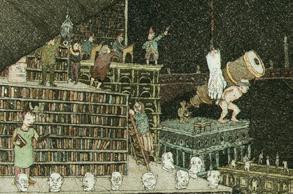
18
The Library of Alexandria burns in alphabetical order
The Emperor Qui Shi Huang’s army of terracotta scholars
Prospero Flees with his most Precious Books
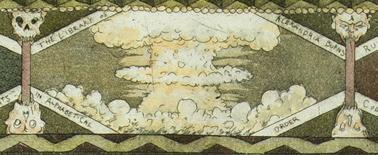


19
a list of those named, and illustrated a few of the panels in photographs. To go further, you will have to follow Powell’s reading list, and learn the tale of each individual ghost paged within the library’s walls. It is also worth looking up the word ‘aedicule’ before you enter. An aedicule was a shrine or a small niche in a larger building. In this way a church (or a library) could be vast and infinitely small at the same time.You could put an aedicule within an aedicule and so on infinitum. In this way, all ghosts and stories can be contained in one place.
Literature, art and the real world is quantum, not Newtonian.
Here is a list of the named stories in this work…
Laurence of Hutton Amidst the Masks of the Dead
Leontes Realised Hermione will Remain a Statue
Iphigenia
Choragic
Tobit and his Dad
Burying the Scholars
Burning of Books
Don Quixote
Diogenes Searches for the Bones of a King
Kora of Sicyon Makes art with the Archive
Nadar Photographs the Corpse of Abel
Noah Sails on an Ack of Extinct Beasts
Rudolf II in his Collection of Collectors
Cicero Teaches how to Die
John Soane’sTombTelecomunicates with the Dead
ATree of Knowledge
Dreams of the Rood

20
Orpheus Samples the Record Collection of the Underworld
The Library of Alexandria burns in Alphabetical Order
The Emperor Qui Shi Huang’s Army ofTerracotta Scholars
Prospero Flees with his most Precious Books
A tree of Knowledge Dreams of the Rood
These are only a few of the stories contained in the library. There are plenty more, but the filing system is a little complicated.
Cicero Teaches How to Die
& John Soane’sTombTelecomunicates with the Dead
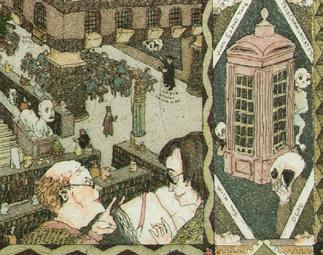
21
22
Highland Book Prize 2022 Longlist
Slightly Foxed Biography 2023 Shortlist
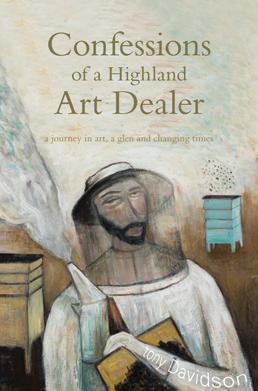
23
Three Questions to Lotte Glob
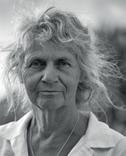
Your work comes from the land and the spirit within it- lochs, mountains, stones, as living beings. When did you first feel this connection and how do natural forces shape your work?
I remember clearly the moment I first felt that connection. I was seven years old and had just arrived - at 3am - with my family in a remote Norwegian glen. I recall the giant mountains, the rocks, the trees, the smells and the stillness of the land. I remember hearing the distant sounds of a waterfall and I knew from that moment where I wouldn’t want to live. From then on I drew mountains, trees and waterfalls and I have been roaming on beaches, forests and fields, drawing, collecting and making things from the natural objects that I find, including, of course, clay - and I haven’t stopped yet!
24
Indigenous cultures acknowledge kinship holistically- land, water, sky, plants, animals, and people as part of a whole ecosystem. How does this idea of kinship relate to your Danish ancestry and your roots in the Northwest of Scotland?
My childhood in Denmark was rooted in history. Icelandic sagas and Nordic fables were the stories I read and from an early age I was helping my father, an archaeologist, with his work. I would be set tasks to scrape moss off boulders, looking for old rock drawings which he needed to record. I trailed behind him through the landscape as he took photographs of graveyards, old trees, monuments, the remnants of the past. In this way the past became my future.
At nineteen years old, I arrived in Scotland. I had an instant feeling of connection to the land and the people of the north. My work has always
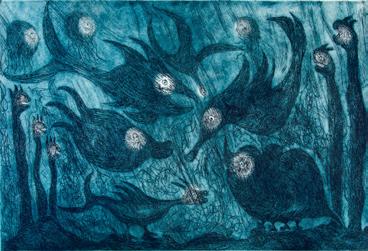
25
Heading for the Shore | hand-coloured etching | 41cm x 60cm
Your Eriboll creatures are joyful expressions of being at one with the landscape and also the child within. How important is play in the studio and how does this influence how you
arisen from the world around me, both natural and human - I hear the geology, I feel the culture and history of the people in the old sites, the ruins, the ancient villages and I feel part of the past. I have also travelled extensively in the nordic landscape, in Faeroes, Iceland and Greenland. So, to answer your question, deep down inside me I am carrying an old Viking.
For me play equals experiment equals learning equals exploring equals surprise equals creativity equals fun. Play gives you the freedom to create.
Play for me is serious and hard work. You don’t so much have ideas as ideas find you. Then you are caught by them and have to follow them, just as it was at seven years old, but with the help of the technical skills I have learned over many years.
It is important for me to be out in the landscape, observing, absorbing, thinking or just clearing my mind of thought. My Loch Eriboll creatures arise from this process but they are not always joyful things. They are troubled beings, emerging from polluted seas, leaving behind the once pristine waters, coming to the land to question the irresponsible actions of man.
26


27
Gnasher | ceramic
Flying creature
Survival Man
Alan MacDonald oil on board

28
35cm x 30cm
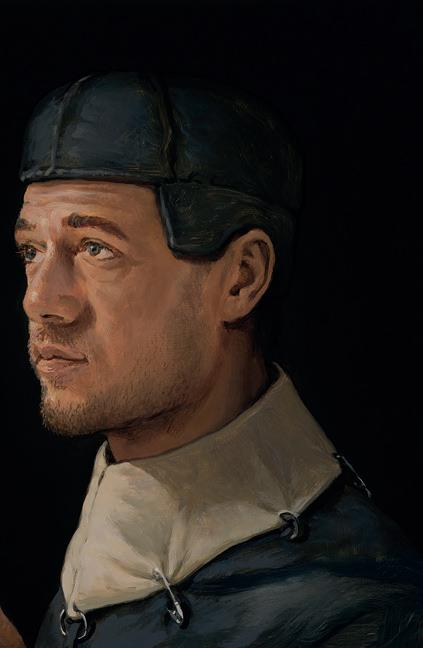
from the vaults
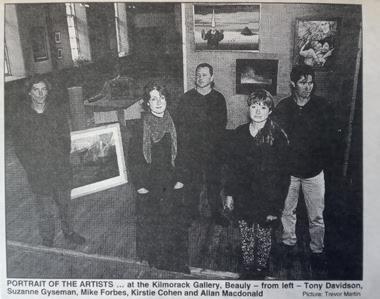
30 +44 (0) 1463 783 230 art@kilmorackgallery.co.uk by beauly, inverness-shire iv4 7al
New Kids. This is a photo from the gallery’s second exhibition (1997) with Tony Davidson, Suzanne Gyseman, Michael Forbes, Kirstie Cohen and Allan MacDonald.

32






 Landscape Study ii | KIRSTIE COHEN
Flowers on a Pink Ground | ANN ORAM
Earth Strata Jar | PATRICIA SHONE
Landscape Study ii | KIRSTIE COHEN
Flowers on a Pink Ground | ANN ORAM
Earth Strata Jar | PATRICIA SHONE

 by Patricia Shone
Erosion Bottle, 2022 raku
13cm(h) x 10cm(d)
by Patricia Shone
Erosion Bottle, 2022 raku
13cm(h) x 10cm(d)
 Patrica Shone, February 2023
Patrica Shone, February 2023


 Lizzie Rose
by Lizzie Rose
Lizzie Rose
by Lizzie Rose


 Sweet Pea 4 acrylic and pencil 29cm x 29cm
Sweet Pea 4 acrylic and pencil 29cm x 29cm


















